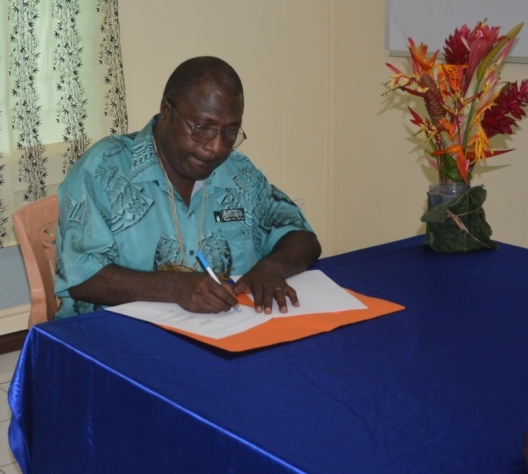By Leonard Fong Roka
My uncle Steven Domiura is just 32 years of age and over this relatively short period of time he has witnessed the burden that local population growth has put on the few forest resources that his communities in the Tumpusiong Valley of Panguna District can reach to improve their living standards.
A trip to mill my timber at Nakorei Village in Buin last December was a cry in his heart.
The hardwood tropical tree (called bee in Nasioi, tolas in Buka or Moikui to the Buin people) is a sought after tree for building homes across Bougainville. It is sawn raw or felled and left to decompose its outer bark and expose the hardwood and timber millers love it since their chainsaw reaps the tree easily despite its hardness and weight.
In the Upper Tailings zone of the Tumpusiong Valley this valuable timber tree, both those matured and standing and those felled many years ago and laying on the ground, have now disappeared. There are a few still buried in the Panguna mine created tailings of the Tumpusiong Valley but that will take some period to await erosion to expose them for the timber hungry Tumpusiong people.
Since getting his chainsaw four years ago, Domiura had not touched a bee in his timber milling career at home, but a trip to Nakorei Village was mesmerizing as he was hopping for four days from bee to bee, around the tiny hamlet of my in-laws.
“In Panguna today we have the money or have easy access to cash but no tree to cut and mill timber to build our homes,” he said in Buin.
“Unlike up at Panguna, the people at Nakorei village struggle a little to make money but they have the resources like the jungle to help them improve their living standards.
“In Buin’s Nakorei Village everywhere you look there is a moikui lying on the ground or standing in the forest waiting to be milled for timber, but in Panguna every maturing tree is felled day by day to meet their needs.”
Most people in the Panguna District now go searching for timber into the Bana, Siwai and Buin Districts of South Bougainville. At home most are penetrating deep into Bougainville’s mountain backbone the Crown Prince Range, while others travel north on the east coast of Bougainville as far as Wakunai District for timber. Others are growing their own trees or buying timber at the many timber yards in Arawa Town.
For Steven Domiura and his chainsaw Nakorei Village was a shock. Out of the 350 pieces of timber on my list he milled 230 pieces in four days, intermittently giving way to the downpour of rain.
‘The bee here is too much,’ he was joked, “in the kitchen huts, under all these sago thatched homes they lay waiting for a chainsaw to cut them up.”
“In the gardens and the cocoa plots the timber hoisting trees are there.”
“Many of these trees, felled some years back, have decomposed their outer softer skin layers and are now dry that the chainsaw has no difficulty penetrating the bole so I have the efficiency to get more timber in a day.”
Steven and his machine will be back in Buin in February to complete his contract of milling my timber for a house in Buin and continue onto extracting timber for a house in Panguna.
Milling timber in Buin for Panguna has its own costs especially transport from Buin to Panguna that is about K1000. Getting Steven to Buin from Panguna costs some money. His chainsaw hire goes for a K150 per day and the operator goes for a K100 per day including his assistants.
The chainsaw’s fuel and lubricants gets a toll on pockets. In Arawa petrol hangs around K5 per litre and the pre-mix goes to K6 and in Buin it goes up to K6 per litre and the premix goes to K7. While the 2-stroke oils to mix with the petrol vary in accordance to their container sizes.
The engine oil to cool the cutting chain is the most expensive item so most rural chainsaw operators now prefer cooking oil for their machines, but nothing should come in between to bringing a chainsaw man from Panguna to Buin.
There is a belief, perhaps embellished, across the timber milling populace of Bougainville that a chainsaw man from an environment with no trees will kill any tree with more efficiency than the chainsaw man from the tree-rich environment.
 Previously published was a legend of the emergence of the coconut palm recorded by a German professor, Ernst Frizzi, in 1911 when he travelled to Bougainville on an ethnographic expedition.
Previously published was a legend of the emergence of the coconut palm recorded by a German professor, Ernst Frizzi, in 1911 when he travelled to Bougainville on an ethnographic expedition. The warrior dance is a part of Koromira culture; traditionally performed for visiting chiefs or tribes.
The warrior dance is a part of Koromira culture; traditionally performed for visiting chiefs or tribes. Festively decorated house to celebrate a Sing-Sing. The adornment, consisting of coconuts, bananas, taro and more.
Festively decorated house to celebrate a Sing-Sing. The adornment, consisting of coconuts, bananas, taro and more. PNG Electoral Commissioner Patilias Gamato signing the MOU in Buka last week.
PNG Electoral Commissioner Patilias Gamato signing the MOU in Buka last week.